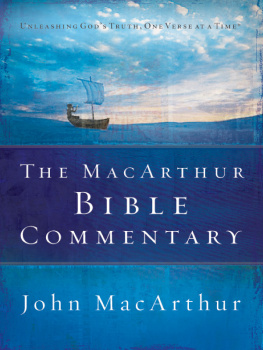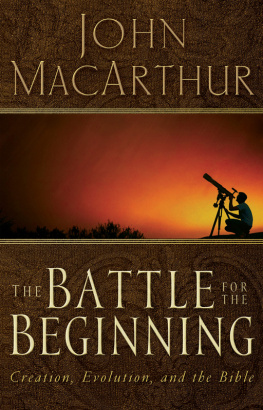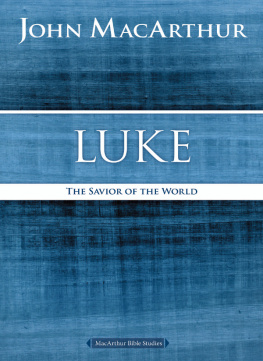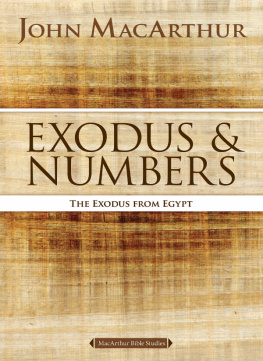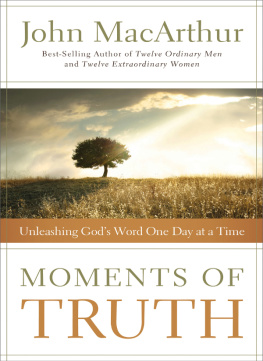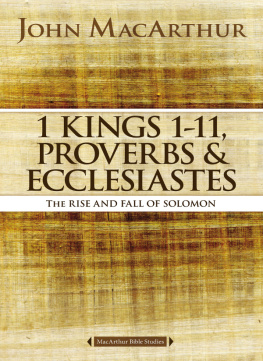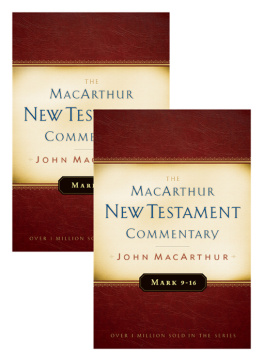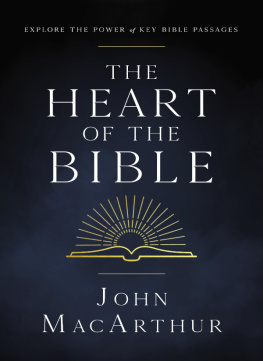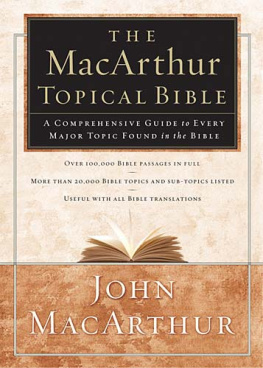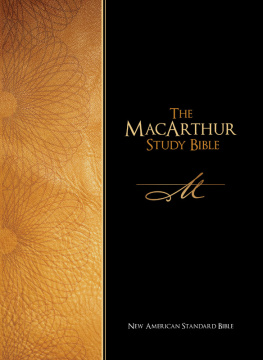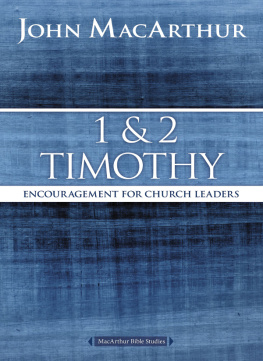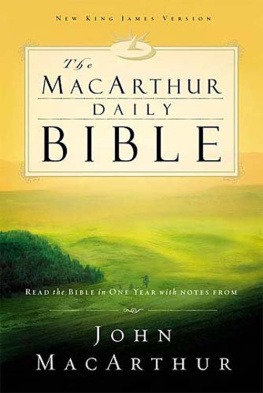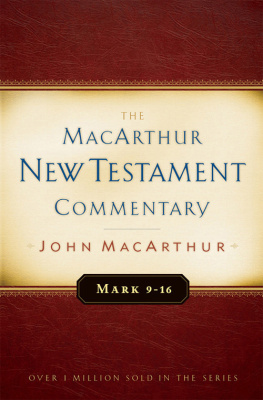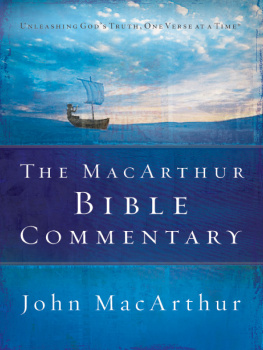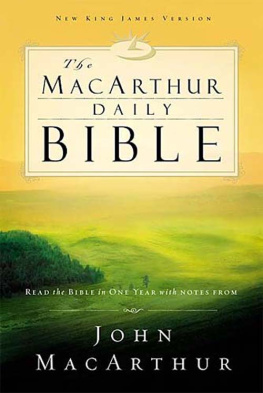
UNLEASHING GODS TRUTH, ONE VERSE AT A TIME.
THE MACARTHUR
BIBLE
COMMENTARY
John MacArthur

THE MACARTHUR BIBLE COMMENTARY
Copyright 2005 by John MacArthur
All rights reserved. No portion of this book may be reproduced, stored in a retrieval system, or transmitted in any form by any means-electronic, mechanical, photocopy, recording, scanning, or other-except for brief quotations in critical reviews or articles, without the prior written permission of the publisher.
Published in Nashville, Tennessee by Thomas Nelson, Inc.
Published in association with the literary agency of Wolgemuth & Associates, Inc.
Thomas Nelson, Inc., titles may be purchased in bulk for educational, business, fundraising, or sales promotional use. For information, please email SpecialMarkets@ThomasNelson.com
John MacArthur
Unleashing Gods Truth, One Verse at a Time
Unleashing Gods Truth, One Verse at a Time is a trademark of Grace to You.
All rights reserved.
Unless otherwise indicated, Scripture quotations are from the New King James Version
1982 by Thomas Nelson, Inc. All rights reserved
Interior design and typesetting by Kristy Morell, Smyrna, Tennessee
ISBN-10: 0-7852-5066-2
ISBN-13: 9-780-7852-5066-1
Printed in the United States of America
07 08 09 10 12 11 10 9 8
CONTENTS
General Information
And Ezra opened the book in the sight of all the people... they read distinctly from the book, in the Law of God; and they gave the sense, and helped them to understand the readingNehemiah 8:5, 8 (NKJV)
A lthough this momentous renewal of interest in Scripture occurred over 2,400 years ago (c. 445 B.C.), this has been the primary need of every subsequent generation, i.e., to read and understandfor the purpose of obediencethe Bible and to thereby know the blessing of God (Rev. 1:3). Therefore, I have undertaken, with the encouragement of Wayne Kinde at Thomas Nelson and the editorial partnership of Dr. Richard Mayhue, executive vice president of The Masters College and Seminary, to create a one-volume commentary which will meet this spiritual need in the twenty-first century.
The core around which this one-volume commentary has been arranged is the original notes of The MacArthur Study Bible published in 1997. Since then, (1) those notes have been thoroughly reviewed for accuracy and clarity, with appropriate revisions and corrections. (2) The outline for each book (located with the Introduction) has been integrated into the commentary. (3) A Further Study section has been added at the end of the commentary for each book which contains a bibliography of several other commentaries which can be consulted to expand on ones studies. (4) Most significantly, over 300 new maps, charts, diagrams, and word studies have been added to the over 350 found in the original MacArthur Study Bible for a total of almost 700 study/teaching aids, in addition to the commentary material.
This one-volume commentary on the whole Bible is in itself a minilibrary which will be especially advantageous to those with financial and/or space limitations. To greatly expand the value of this commentary, ones studies can be vastly enhanced with the additional use of The MacArthur Topical Bible.
Everyone from new believers to pastors can benefit from this study tool. Its purpose and design are to make the precious truths of Scripture understandable and consequently obeyed by the people of God. May Gods promise to Joshua over 3,400 years ago be just as real today because you have used this volume to know, understand, and obey the Word of God.
This Book of the Law shall not depart from your mouth, but you shall meditate in it day and night, that you may observe to do according to all that is written in it. For then you will make your way prosperous, and then you will have good success
Joshua 1:8 (NKJV)
THE NATURE AND PURPOSE OF THE
BIBLE
T he Bible is a collection of 66 documents inspired by God. These documents are gathered into two testaments, the Old (39) and the New (27). Prophets, priests, kings, and leaders from the nation of Israel wrote the OT books in Hebrew (with two passages in Aramaic). The apostles and their associates wrote the NT books in Greek. The two testaments go from creation to consummation, eternity past to eternity future.
The OT record starts with the creation of the universe and closes about four hundred years before the first coming of Jesus Christ.
The flow of history through the OT moves along the following lines:
Creation of the universe
Fall of man
Judgment flood over the earth
Abraham, Isaac, Jacob (Israel)fathers of the chosen nation
The history of Israel
Exile in Egypt430 years
Exodus and wilderness wanderings40 years
Conquest of Canaan7 years
Era of Judges350 years
United KingdomSaul, David, Solomon110 years
Divided KingdomJudah/Israel350 years
Exile in Babylon70 years
Return and rebuilding the land140 years
The details of this history are explained in the 39 books divided into 5 categories:
The Law5 (GenesisDeuteronomy)
History12 (JoshuaEsther)
Wisdom5 (JobSong of Solomon)
Major Prophets5 (IsaiahDaniel)
Minor Prophets12 (HoseaMalachi)
After the completion of the OT, there were four hundred years of silence, during which God did not speak or inspire any Scripture. That silence was broken by the arrival of John the Baptist announcing that the promised Lord Savior had come. The NT records the rest of the story from the birth of Christ to the culmination of all history and the final eternal state.
While the thirty-nine OT books major on the history of Israel and the promise of the coming Savior, the twenty-seven NT books major on the person of Christ and the establishment of the church. The four Gospels give the record of His birth, life, death, resurrection, and ascension. Each of the four writers views the greatest and most important event of history, the coming of the God-man, Jesus Christ, from a different perspective. Matthew looks at Him through the perspective of His kingdom; Mark through the perspective of His servanthood; Luke through the perspective of His humanness; and John through the perspective of His deity.
The Book of Acts chronicles the impact of the life, death, and Resurrection of Jesus Christ, the Lord and Saviorfrom His Ascension, the consequent coming of the Holy Spirit, and the birth of the church, through the early years of gospel preaching by the apostles and their associates. Acts records the establishment of the church in Judea, Samaria, and into the Roman Empire.
The twenty-one epistles were written to churches and individuals to explain the significance of the person and work of Jesus Christ, with its implications for life and witness until He returns.
The NT closes with Revelation, which starts by picturing the current church age, and culminates with Christs return to establish His earthly kingdom, bringing judgment on the ungodly and glory and blessing for believers. Following the millennial reign of the Lord Savior will be the last judgment, leading to the eternal state. All believers of all history enter the ultimate eternal glory prepared for them, and all the ungodly are consigned to hell to be punished forever.
To understand the Bible, it is essential to grasp the sweep of that history from creation to consummation. It is also crucial to keep in focus the unifying theme of Scripture. The one constant theme unfolding throughout the whole Bible is this: God for His own glory has chosen to create and gather to Himself a group of people to be the subjects of His eternal kingdom, to praise, honor, and serve Him forever and through whom He will display His wisdom, power, mercy, grace, and glory. To gather His chosen ones, God must redeem them from sin. The Bible reveals Gods plan for this redemption from its inception in eternity past to its completion in eternity future. Covenants, promises, and epochs are all secondary to the one continuous plan of redemption.
Next page
